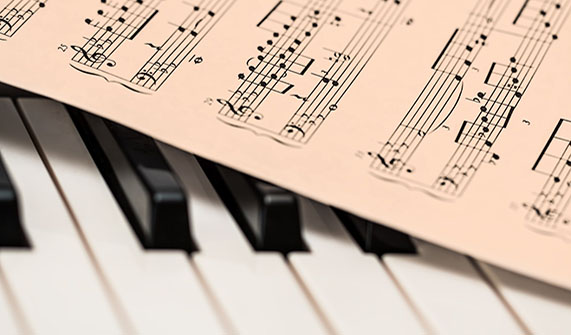All musicians start by learning to read music. Just as we learn to read by learning the alphabet, we learn to read music by learning the notes. But the lines and dots on a musical score can intimidate the beginner musician. To alleviate that stress, here are six easy steps to learn your notes.
Step 1: The Grand Staff
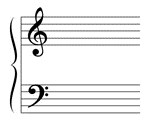
The Grand Staff consists of two sets of lines and spaces with corresponding signs. The upper sign is called the Treble Clef. The lower sign is the Bass Clef.
Notes sit on the lines and in the spaces in each Clef.
Let’s look at the Treble Clef in more detail in Step 2.
Step 2: The Treble Clef and Notes
The Treble Clef has 5 lines and 4 spaces. Each line and space holds a specific note.
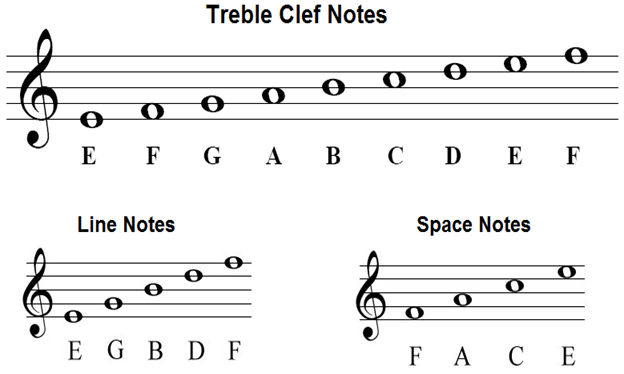
The notes on the 4 spaces are F, A, C, & E.
The notes on the 5 lines are E, G, B, D, & F.
Always read the notes, whether on lines or in spaces, from the bottom to the top of the staff.
Notice that the space notes spell “FACE”. To help you memorize the line notes, make up a phrase such as, “Every Good Boy Deserves Fudge.”
Let’s look at the notes on the Bass Clef.
Step 3: The Bass Clef and Notes

The Bass Clef also contains 5 lines and 4 spaces, with each holding a specific note.
The notes on the 4 spaces are A, C, E, & G.
The notes on the 5 lines are G, B, D, F, & A.
As with the Treble Clef, whether on lines or in spaces, from the bottom to the top of the staff.
A memorization tool for the Bass lines could be, “Good Boys Deserve Fudge Always,” and “All Chickens Eat Greens,” for the Bass spaces. Find a phrase that speaks to you.
In Step 4 we put the Treble and Bass Clefs together on the Grand Staff.
Step 4: The Grand View of All Notes in the Treble and Bass Clefs
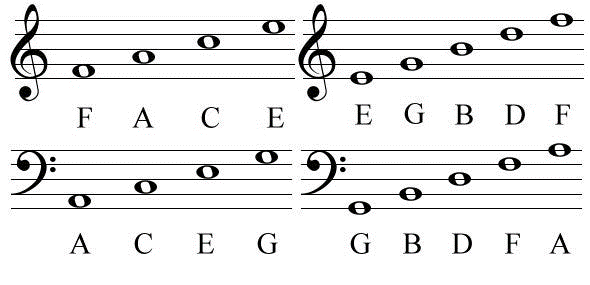
Here are all the notes, on the lines and spaces, in the Treble and Bass Clefs. Read the notes over many times and use your memorization tools to learn the notes. Try looking away from the Clefs and naming the line or space notes. Do this every day until you know the notes.
But what about notes on the lines outside of the Grand Staff? They are ledger lines and we review them in Step 5.
Step 5: Ledger Lines

Ledger lines are added for notes landing outside the Grand Staff. They are in the Treble and Bass Clefs but only appear if a piece has notes above or below the Grand Staff.
A common note on a ledger line, especially for piano players, is Middle C.
Step 6: The First Ledger Line Note – Middle C
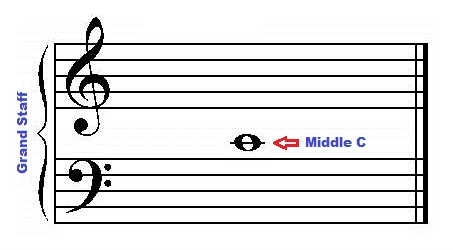
Middle C is found between the Treble and Bass Clefs.
The next note above Middle C, moving up to the Treble Clef, is D. Then you reach E, the first line note in the Treble Clef.
Below Middle C, moving down to the Bass Clef, is B. Then you meet A, the top line note for the Bass Clef.
You’ll encounter more ledger notes as you continue your musical studies.
When you meet a ledger note you don’t know, find an “anchor” note – or the nearest note you do know, and count up or down until you reach the ledger note.
Two Extra Tips:
1. When playing a note on your favourite instrument, identify whether the note is on a line or in a space to reinforce that information in your head.
2. Remember to learn your notes from the bottom line or space to the top of the staff.
If you’re ready to learn notes, and tap into your musical talent, visit the Brady Arts Academy website. We offer courses in vocal and musical training.
Written by: Nicole Holas


